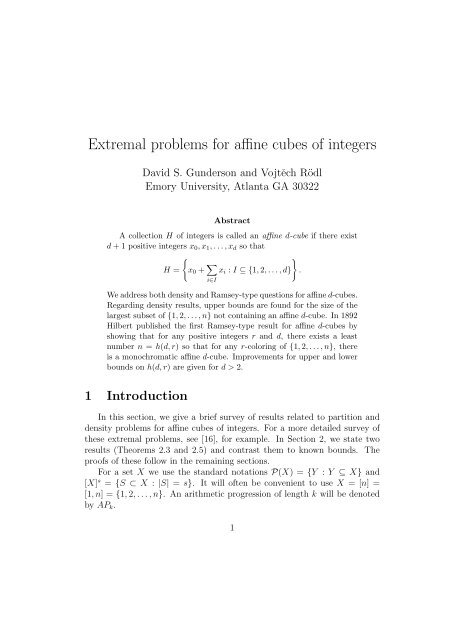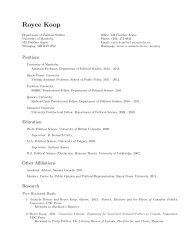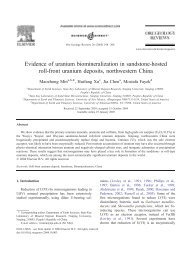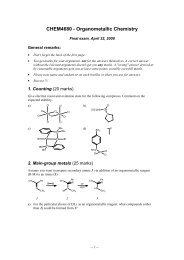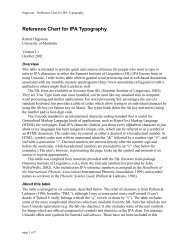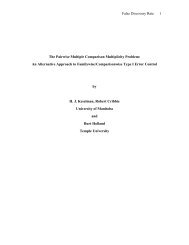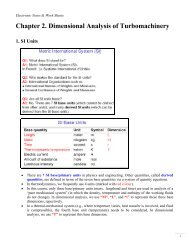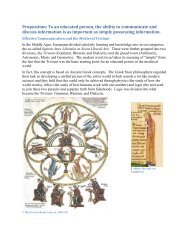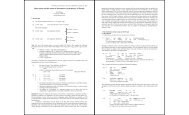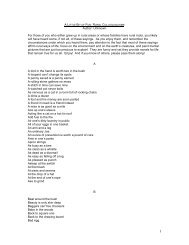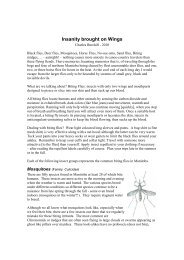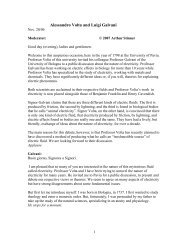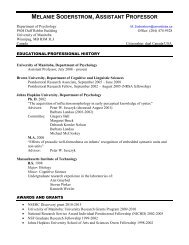Extremal problems for affine cubes of integers - University of Manitoba
Extremal problems for affine cubes of integers - University of Manitoba
Extremal problems for affine cubes of integers - University of Manitoba
You also want an ePaper? Increase the reach of your titles
YUMPU automatically turns print PDFs into web optimized ePapers that Google loves.
<strong>Extremal</strong> <strong>problems</strong> <strong>for</strong> <strong>affine</strong> <strong>cubes</strong> <strong>of</strong> <strong>integers</strong><br />
David S. Gunderson and Vojtěch Rödl<br />
Emory <strong>University</strong>, Atlanta GA 30322<br />
Abstract<br />
A collection H <strong>of</strong> <strong>integers</strong> is called an <strong>affine</strong> d-cube if there exist<br />
d + 1 positive <strong>integers</strong> x0, x1, . . . , xd so that<br />
<br />
H = x0 + <br />
<br />
xi : I ⊆ {1, 2, . . . , d} .<br />
i∈I<br />
We address both density and Ramsey-type questions <strong>for</strong> <strong>affine</strong> d-<strong>cubes</strong>.<br />
Regarding density results, upper bounds are found <strong>for</strong> the size <strong>of</strong> the<br />
largest subset <strong>of</strong> {1, 2, . . . , n} not containing an <strong>affine</strong> d-cube. In 1892<br />
Hilbert published the first Ramsey-type result <strong>for</strong> <strong>affine</strong> d-<strong>cubes</strong> by<br />
showing that <strong>for</strong> any positive <strong>integers</strong> r and d, there exists a least<br />
number n = h(d, r) so that <strong>for</strong> any r-coloring <strong>of</strong> {1, 2, . . . , n}, there<br />
is a monochromatic <strong>affine</strong> d-cube. Improvements <strong>for</strong> upper and lower<br />
bounds on h(d, r) are given <strong>for</strong> d > 2.<br />
1 Introduction<br />
In this section, we give a brief survey <strong>of</strong> results related to partition and<br />
density <strong>problems</strong> <strong>for</strong> <strong>affine</strong> <strong>cubes</strong> <strong>of</strong> <strong>integers</strong>. For a more detailed survey <strong>of</strong><br />
these extremal <strong>problems</strong>, see [16], <strong>for</strong> example. In Section 2, we state two<br />
results (Theorems 2.3 and 2.5) and contrast them to known bounds. The<br />
pro<strong>of</strong>s <strong>of</strong> these follow in the remaining sections.<br />
For a set X we use the standard notations P(X) = {Y : Y ⊆ X} and<br />
[X] s = {S ⊂ X : |S| = s}. It will <strong>of</strong>ten be convenient to use X = [n] =<br />
[1, n] = {1, 2, . . . , n}. An arithmetic progression <strong>of</strong> length k will be denoted<br />
by APk.<br />
1
1.1 Arithmetic progressions<br />
In 1927, van der Waerden published his well known partition theorem <strong>for</strong><br />
<strong>integers</strong> (see also [36] <strong>for</strong> history <strong>of</strong> its pro<strong>of</strong>).<br />
Theorem 1.1 (van der Waerden [35]) For every pair <strong>of</strong> positive <strong>integers</strong><br />
k and r, there exists a least n = W (k, r) so that <strong>for</strong> any partition <strong>of</strong><br />
[1, n] into r classes, one class contains an APk.<br />
For more pro<strong>of</strong>s <strong>of</strong> van der Waerden’s theorem we refer the reader to any<br />
<strong>of</strong>, <strong>for</strong> example, [3], [13], [15], [19], [20], or [30]. The function W(k, r) is<br />
primitive recursive (see [30]), and aside from a few small values, not much<br />
more is known about upper bounds <strong>for</strong> W(k, r).<br />
In 1946, Behrend proved a (lower bound) density result <strong>for</strong> subsets <strong>of</strong><br />
[1, n] not containing any AP3. (See [9] and [10] <strong>for</strong> related results.)<br />
Theorem 1.2 (Behrend [1]) There exists a constant c so that <strong>for</strong> m<br />
sufficiently large, there exists an AP3-free set B ⊂ [1, m] with<br />
1.2 Affine <strong>cubes</strong><br />
|B| ≥ me −c√ ln m = m 1−o(1) .<br />
In 1892, Hilbert [22] proved the first non-trivial partition Ramsey-type<br />
theorem. This theorem, which preceded the celebrated Schur and van der<br />
Waerden theorems, states that in any finite coloring <strong>of</strong> the set <strong>of</strong> positive<br />
<strong>integers</strong>, there exists a monochromatic “<strong>affine</strong> d-cube” (defined below).<br />
Definition 1.3 A collection H <strong>of</strong> <strong>integers</strong> is called a d-dimensional <strong>affine</strong><br />
cube, or simply, an <strong>affine</strong> d-cube if and only if there exist d + 1 positive<br />
<strong>integers</strong> x0, x1, . . . , xd so that<br />
<br />
H = x0 + <br />
<br />
xi : I ⊆ [1, d] .<br />
i∈I<br />
If all sums are distinct, that is, if |H| = 2 d , then we say that the <strong>affine</strong> d-cube<br />
is replete.<br />
2
If an <strong>affine</strong> d-cube H is generated by x0, x1, . . . , xd, then we write H =<br />
H(x0, x1, . . . , xd). For example, H(1, 1, 1) = {1, 2, 3}, while a replete <strong>affine</strong> 2cube<br />
is H(1, 3, 9) = {1, 4, 10, 13}. We note that H(x0, x1, . . . , xd) may differ<br />
from, say, H(x1, x0, . . . , xd).<br />
Hilbert originally proved that if the positive <strong>integers</strong> are colored with<br />
finitely many colors, then one color class contains a (monochromatic) d-cube.<br />
By compactness, a finite version also holds.<br />
Theorem 1.4 (Hilbert [22]) For every r, d, there exists a least number<br />
h(d, r) so that <strong>for</strong> every coloring<br />
χ : [h(d, r)] → [1, r],<br />
there exists an <strong>affine</strong> d-cube monochromatic under χ.<br />
Theorem 1.4 now follows from van der Waerden’s Theorem since an APd+1<br />
given by {a, a+k, a+2k, . . . , a+dk} is also an <strong>affine</strong> d-cube H(a, k, k, . . . , k).<br />
There have been many, in some sense, strengthened versions <strong>of</strong> Hilbert’s<br />
result by eliminating the x0 in Definition 1.3. For a set {x1, . . . , xd}, the<br />
set <strong>of</strong> all finite non-empty sums { <br />
i∈I xi : I ⊆ [1, d], I = ∅} is sometimes<br />
called a projective d-cube (see, <strong>for</strong> example, [26]) or finite sum set. For an<br />
infinite set {x1, x2, . . .}, the set <strong>of</strong> all finite non-empty sums is said to be an<br />
infinite-dimensional projective cube or a Hindman set.<br />
Rado [27], and later independently, Sanders [28] and Folkman (see [15] or<br />
[17]), showed that <strong>for</strong> any r and d, there exists a least number n = FRS(r, d)<br />
so that <strong>for</strong> any partition <strong>of</strong> [1, n] into r classes, one class contains a projective<br />
d-cube. The case d = 2 is the celebrated Schur’s Theorem [29]. Hindman [23]<br />
settled a conjecture <strong>of</strong> Graham and Rothschild [18] by showing that upon<br />
any finite coloring <strong>of</strong> the positive <strong>integers</strong>, there exists a monochromatic<br />
infinite-dimensional projective cube. Any known upper bounds on FRS(r, d)<br />
are tower functions (see [34] or [16] <strong>for</strong> discussion) and <strong>for</strong> large d, there<br />
is a huge gap between upper and lower bounds. In Theorem 2.5, we give<br />
relatively tight bounds <strong>for</strong> h(d, r).<br />
2 Results<br />
In 1969, Szemerédi proved that if a set A <strong>of</strong> positive <strong>integers</strong> has positive<br />
upper density, (i.e., lim |A ∩ [1, n]|/n > 0) then A contains an AP4. In<br />
n→∞<br />
3
the same paper (Lemma p(δ, l), p. 93), Szemerédi gave a density version <strong>of</strong><br />
Theorem 1.4; this density version has since become known as “Szemerédi’s<br />
cube lemma” (cf. [20]).<br />
Theorem 2.1 (Szemerédi’s cube lemma [32]) For any 0 < ɛ < 1<br />
and positive integer d, there exists n0 = n0(ɛ, d) so that <strong>for</strong> all n ≥ n0, if<br />
A ⊂ [1, n] and |A| > ɛn then A contains an <strong>affine</strong> d-cube.<br />
Szemerédi’s pro<strong>of</strong> was by induction on d, and although no explicit bounds<br />
on n0 are mentioned, the argument shows that n0(ɛ, d) is much larger than<br />
(2/ɛ) 2d.<br />
Another pro<strong>of</strong> <strong>of</strong> (a strengthened version <strong>of</strong>) Szemerédi’s cube lemma was<br />
found by Graham et al [15] and [20]. Lovász [25] (Problem 14.12) gives two<br />
pro<strong>of</strong>s, one elegant pro<strong>of</strong> using Ramsey’s theorem, and another, based on the<br />
same idea as in [15] and [20] which actually proves the following:<br />
Theorem 2.2 Let d ≥ 2 be given. Then there exists n0 = n0(d) so that<br />
<strong>for</strong> every n ≥ n0, if A ⊆ [1, n] satisfies<br />
then A contains an <strong>affine</strong> d-cube.<br />
1<br />
1−<br />
|A| ≥ (4n) 2d−1 ,<br />
We point out that in the pro<strong>of</strong> <strong>of</strong> Theorem 2.2 no attempt was made to<br />
find the best possible constant. In Section 3, we modify this pro<strong>of</strong> further<br />
and obtain the following improvement in the constant and are explicit about<br />
bounds on n0(d).<br />
Theorem 2.3 Let d ≥ 3 be given. Then there exists n0 = n0(d) ≤<br />
2 d2d−1<br />
2 d−1 −1 −1 so that <strong>for</strong> every n ≥ n0, if A ⊆ [1, n] satisfies<br />
then A contains an <strong>affine</strong> d-cube.<br />
1<br />
1−<br />
|A| ≥ 2 2d−1 ( √ 1<br />
2−<br />
n + 1) 2d−2 ,<br />
For reference, we note a modest improvement over Theorem 2.2.<br />
4
Corollary 2.4 For d ≥ 3 there exists n0 ≤ ( 2d −2<br />
ln 2 )2 so that <strong>for</strong> every<br />
n ≥ n0, if A ⊆ [1, n] satisfies<br />
then A contains an <strong>affine</strong> d-cube.<br />
1<br />
1−<br />
|A| ≥ 2n 2d−1 We leave it to the reader to check that the hypotheses <strong>of</strong> Corollary 2.4<br />
indeed satisfy the hypotheses in Theorem 2.3. In Section 5 we give yet<br />
another pro<strong>of</strong> <strong>of</strong> Szemerédi’s cube lemma based on an extremal result <strong>for</strong><br />
hypergraphs.<br />
In [2] it was shown that h(2, r) = (1+o(1))r 2 ; the lower bound uses Singer<br />
sets (cyclic difference sets arising from a finite projective plane, see also [31])<br />
and the upper bound follows from well known bounds <strong>for</strong> B2-sets, or Sidon<br />
sets (see also [6]). Also in [2], it was noted that there exist constants c1 and<br />
c2 so that<br />
r c1d ≤ h(d, r) ≤ r (c2) d<br />
, (1)<br />
where c2 ∼ 2.6 follows from Hilbert’s original pro<strong>of</strong> (using Fibonacci numbers).<br />
Section 6 is devoted to the pro<strong>of</strong> <strong>of</strong> the following improvement <strong>of</strong> both<br />
bounds in (1) <strong>for</strong> d > 2.<br />
Theorem 2.5 For any <strong>integers</strong> d ≥ 3 and r ≥ 2,<br />
where o(1) → 0 as r → ∞.<br />
r (1−o(1))(2d −1)/d ≤ h(d, r) ≤ (2r) 2 d−1<br />
3 Pro<strong>of</strong> <strong>of</strong> Theorem 2.3<br />
In the pro<strong>of</strong> <strong>of</strong> Theorem 2.3, we will use the following lemma without<br />
pro<strong>of</strong>.<br />
Lemma 3.1 If n ≥ 2 and b ≥ ( √ n + 1)/2, then (b 2)<br />
n−1 ≥<br />
b 2<br />
2( √ n+1) 2 .<br />
Pro<strong>of</strong> <strong>of</strong> Theorem 2.3: Fix d ≥ 3 and n ≥ 2 d2d−1<br />
2 d−1 −1 −1 . Let A ⊆ [1, n] satisfy<br />
1<br />
1−<br />
|A| ≥ 2 2d−1 ( √ 1<br />
2−<br />
n + 1) 2d−2 . (2)<br />
5
For any real x, we use the standard notation A − x = {a − x : a ∈ A}.<br />
For each i ∈ [1, n − 1], define<br />
Since<br />
Ai = A ∩ (A − i). (3)<br />
<br />
n−1 |A|<br />
|Ai| = , (4)<br />
i=1 2<br />
we can find i1 ∈ [1, n − 1] so that |Ai1| ≥ (|A| 2 )<br />
. Similarly, there exists i2<br />
n−1<br />
so that <strong>for</strong> Ai1,i2 = Ai1 ∩ (Ai1 − i2), we have |Ai1,i2| ≥ (|A i |<br />
1<br />
2 )<br />
. Continuing<br />
n−1<br />
this process, there exist i1, i2, . . . , id−1 so that <strong>for</strong> each k = 1, . . . , d − 2, we<br />
recursively define Ai1,i2,...,ik+1 = Ai1,i2,...,ik ∩ (Ai1,i2,...,ik − ik) satisfying<br />
|Ai1,i2,...,ik | ≥<br />
|Ai 1 ,i 2 ,...,i k−1 |<br />
2<br />
n − 1<br />
Observe that Ai1 = {x : x ∈ A, x + i1 ∈ A} and<br />
<br />
. (5)<br />
Ai1,i2 = {x : x ∈ A, x + i1 ∈ A, x + i2 ∈ A, x + i1 + i2 ∈ A}<br />
determines an <strong>affine</strong> 2-cube. It follows that if |Ai1,i2,...,id−1 | ≥ 2, then A<br />
contains an <strong>affine</strong> d-cube; it remains to show this inequality.<br />
For each k, define ak = |Ai1,i2,...,ik |. We have already observed that <strong>for</strong><br />
A to contain a d-cube, it suffices to have ad−1 ≥ 2. Indeed, it follows from<br />
(5) that if ad−2 ≥ √ 2n then ad−1 ≥ 2, and so then A contains a d-cube. So,<br />
assume <strong>for</strong> the moment that ad−2 ≥ √ 2n; then <strong>for</strong> every i = 1, 2, . . . , d − 2,<br />
ai ≥ √ n, and so by Lemma 3.1, and (5),<br />
a1 ≥<br />
a2 ≥<br />
.<br />
ad−2 ≥<br />
<br />
|A|<br />
2<br />
n − 1 ≥<br />
<br />
a1<br />
2<br />
n − 1 ≥<br />
.<br />
ad−3<br />
2<br />
<br />
n − 1 ≥<br />
|A| 2<br />
2( √ ,<br />
n + 1) 2<br />
|A| 2<br />
a2 1<br />
2( √ ( 2(<br />
≥<br />
n + 1) 2 √ n+1) 2 ) 2<br />
2( √ =<br />
n + 1) 2<br />
|A| 2d−2<br />
2 2d−2 −1 ( √ n + 1) 2 d−1 −2 .<br />
6<br />
|A| 4<br />
23 ( √ ,<br />
n + 1) 6
So to guarantee that A contains a d-cube, it suffices to have<br />
and hence it suffices to have<br />
|A| 2d−2<br />
2 2d−2 −1 ( √ n + 1) 2 d−1 −2 ≥ √ 2n,<br />
|A| 2d−2<br />
≥ 2 2d−2 −1/2 ( √ n + 1) 2 d−1 −1 ,<br />
which we have assumed in (2).<br />
We conclude the pro<strong>of</strong> by observing that the condition n ≥ 2<br />
antees that |A| ≥ 2d , enough elements <strong>for</strong> a d-cube. ✷<br />
d<br />
d+<br />
2d−1 guar-<br />
4 The number <strong>of</strong> monochromatic <strong>affine</strong> <strong>cubes</strong><br />
Let n ≥ R(m, m), the Ramsey number <strong>for</strong> m (under 2-colorings <strong>of</strong> edges).<br />
Then under any 2-coloring <strong>of</strong> the edges <strong>of</strong> the complete graph Kn, one is<br />
guaranteed at least one monochromatic copy <strong>of</strong> Km, but can one ascertain<br />
how many monochromatic copies exist? For example, Goodman’s [14] well<br />
known result counts the number <strong>of</strong> triangles in a graph and in its complement,<br />
and shows that the minimum number <strong>of</strong> monochromatic triangles is n(n −<br />
1)(n−5)/24, which is around 1/4 <strong>of</strong> all, that expected from a random coloring.<br />
The similar question can be asked <strong>for</strong> any Ramsey-type partition theorem and<br />
is the subject <strong>of</strong> recent investigation (see [8], [11], [24], or [33] <strong>for</strong> examples).<br />
Let f(n, d, r) be the minimum number <strong>of</strong> monochromatic replete <strong>affine</strong><br />
d-<strong>cubes</strong> in any r-colored [n].<br />
Theorem 4.1 For d ≥ 2, r ≥ 2, and n sufficiently large (larger than<br />
h(d, r)),<br />
nd+1 (2r) 2d n<br />
(1 − o(1)) ≤ f(n, d, r) ≤<br />
−1 d+1<br />
(d + 1)!r2d−1 ,<br />
where o(1) → 0 as n → ∞.<br />
Pro<strong>of</strong>: To prove the lower bound, we use the technique given in the pro<strong>of</strong> <strong>of</strong><br />
Theorem 2.3. Fix a partition C1 ∪ C2 ∪ . . . ∪ Cr = [1, n]. For each α ∈ [1, r],<br />
7
and any choice <strong>of</strong> i1, i2, . . . , id ∈ [1, n − 1], define C α i1 = Cα ∩ (Cα − i1), and<br />
recursively define<br />
C α i1,i2,...,ik+1 = Cα i1,i2,...,ik ∩ (Cα i1,i2,...,ik − ik+1).<br />
If x ∈ C α i1,i2,...,id then {x + d j=1 ɛjij : ɛj = 0, 1} is a monochromatic <strong>affine</strong><br />
d-cube contained in [1, n], so the number <strong>of</strong> monochromatic <strong>affine</strong> d-<strong>cubes</strong> is<br />
r<br />
<br />
α=1 i1,i2,...,id<br />
|C α i1,i2,...,id |,<br />
(where i1, i2, . . . , id range over [1, n − 1]). Using the identity (3) and the<br />
inequality m i=1 |ai| k ≥<br />
m i=1 ai<br />
k m<br />
· m (<strong>for</strong> positive <strong>integers</strong> k,m, and non-<br />
negative numbers ai) repeatedly, we calculate<br />
r <br />
|C<br />
α=1 i1,i2,...,id<br />
α r<br />
<br />
α |Ci1,i2,...,id−1 i1,i2,...,id | =<br />
α=1 i1,i2,...,id−1<br />
|<br />
<br />
2<br />
≥ 1<br />
r<br />
<br />
id−1<br />
2 α=1 i1,i2,...,id−2<br />
|Cα i1,i2,...,id−1 |<br />
2 (n − 1)(1 − o(1))<br />
n − 1<br />
1<br />
r<br />
<br />
α |Ci1,i2,...,id−2 =<br />
2(n − 1) α=1 i1,i2,...,id−2<br />
|<br />
2 (1 − o(1))<br />
2<br />
1<br />
≥<br />
21+2 r<br />
<br />
id−2<br />
(n − 1) α=1 i1,i2,...,id−3<br />
|Cα i1,i2,...,id−2 |<br />
4 (n − 1)(1 − o(1))<br />
n − 1<br />
1<br />
=<br />
21+2 (n − 1) 1+3<br />
r<br />
<br />
α |Ci1,i2,...,id−3 α=1 i1,i2,...,id−3<br />
|<br />
4 (1 − o(1))<br />
2<br />
1<br />
≥<br />
21+2+4 (n − 1) 1+3<br />
r<br />
<br />
id−3<br />
α=1 i1,i2,...,id−4<br />
|Cα i1,i2,...,id−3 |<br />
8 (n − 1)(1 − o(1))<br />
n − 1<br />
1<br />
=<br />
21+2+4 (n − 1) 1+3+7<br />
r<br />
<br />
α |Ci1,i2,...,id−4 |<br />
8 (1 − o(1))<br />
2<br />
≥<br />
.<br />
1<br />
22d−1 (n − 1) 2d−1−d α=1 i1,i2,...,id−4<br />
r<br />
α=1<br />
|Cα| 2d<br />
(1 − o(1))<br />
8
≥<br />
=<br />
1<br />
2 2d −1 n 2 d −1−d<br />
nd+1 (2r) 2d (1 − o(1))<br />
−1<br />
<br />
rα=1 2d |Cα|<br />
r<br />
r(1 − o(1))<br />
where the last line holds since r α=1 |Cα| = n. So we have shown that the<br />
minimum number <strong>of</strong> <strong>affine</strong> d-<strong>cubes</strong> under any r-coloring <strong>of</strong> [n] is at least<br />
nd+1 (2r) 2d (1 − o(1)), and since almost all <strong>affine</strong> d-<strong>cubes</strong> are replete, this gives<br />
−1<br />
the lower bound.<br />
If H(x0, x1, . . . , xd) is a replete <strong>affine</strong> cube, then the generators x1, . . . , xd<br />
are distinct (though this is not a sufficient condition <strong>for</strong> being replete). For<br />
any given x0, the other xi’s can be chosen only from [1, n − x0] and hence<br />
there are less than<br />
<br />
n<br />
d<br />
<br />
n − 1 n − 2 d + 1<br />
+ + + . . . + + 1 =<br />
d d<br />
d<br />
<br />
n + 1<br />
d + 1<br />
replete <strong>affine</strong> d-<strong>cubes</strong> in [1, n]. A random r-coloring <strong>of</strong> [1, n] yields each<br />
cube monochromatic with probability r<br />
r2d , and so we conclude that there is a<br />
coloring with no more than <br />
n+1 1<br />
d+1 r2d monochromatic replete <strong>affine</strong> d-<strong>cubes</strong>.<br />
−1<br />
Hence, f(n, d, r) ≤ . ✷<br />
nd+1<br />
(d+1)!r 2d −1<br />
5 Hypergraphs and Theorem 2.1<br />
A d-uni<strong>for</strong>m hypergraph is a pair G = (V, E) = (V (G), E(G)), with vertex<br />
set V and hyperedge set E ⊂ [V ] d . Note that by this definition, each dset<br />
from V may occur only once as a hyperedge. For pairwise disjoint sets<br />
X1, X2, . . . , Xd, let<br />
G = (X1, X2, . . . , Xd, E(G))<br />
denote a d-partite d-uni<strong>for</strong>m hypergraph on vertex set V (G) = ∪ d i=1Xi and<br />
edge set E(G) ⊆ [V (G)] d , where <strong>for</strong> each E ∈ E(G) and each i = 1, . . . , d,<br />
|E ∩ Xi| = 1 holds; the sets X1, . . . , Xd will be called partite sets.<br />
Let K (d) (n1, n2, . . . , nd) denote the complete d-partite d-uni<strong>for</strong>m hypergraph<br />
on d i=1 ni vertices, partitioned into sets <strong>of</strong> sizes n1, n2 . . . , nd, and<br />
9
having d i=1 ni edges, each edge containing exactly one vertex from each partite<br />
set. The complete d-partite d-uni<strong>for</strong>m hypergraph with two vertices in<br />
each partite set will be denoted by K (d) (2, 2, . . . , 2). For any d-uni<strong>for</strong>m hypergraph<br />
H, the maximum number <strong>of</strong> d-hyperedges in any H-free hypergraph<br />
on n vertices is denoted by ex(n, H). In 1964, Erdős [5] (cf. equation (4.2)<br />
in [12]) showed that <strong>for</strong> each d and m ≥ 2d,<br />
ex(k, K (d) 1<br />
d−<br />
(2, 2, . . . , 2)) ≤ k 2d−1 . (6)<br />
For d > 2, there is still an order <strong>of</strong> magnitude gap between the lower and<br />
upper bounds <strong>for</strong> ex(n, K (d) (2, 2, . . . , 2)) (see [21] <strong>for</strong> discussion). Using these<br />
partite hypergraphs, we now give a novel pro<strong>of</strong> <strong>of</strong> Theorem 2.1 by showing<br />
that if A ⊆ [1, n] and |A| ≥ (3d) d 1<br />
1−<br />
n 2d , then A contains an <strong>affine</strong> d-cube;<br />
we make no attempt to optimize constants (since this result is implied by<br />
Theorem 2.3).<br />
A hypergraph pro<strong>of</strong> <strong>of</strong> Theorem 2.1: Fix d ≥ 2, m ≥ 2d, and let<br />
n = m2 1<br />
1−<br />
. Let A ⊂ [1, n] with |A| ≥ cn 2d , where c = (3d) d . For any q ∈<br />
[1, n], let (s(q), t(q)) ∈ ([0, m − 1]) 2 be the unique pair <strong>of</strong> <strong>integers</strong> satisfying<br />
q − 1 = s(q) √ n + t(q). For each q ∈ A, define<br />
d−1<br />
Eq = {(z1, . . . , zd) ∈ ([−m, m]) d <br />
: zi = s(q), zd = t(q)}.<br />
If s ∈ [0, m − 1], then are at least md−2 ways <strong>of</strong> writing s = d−1 i=1 zi, where<br />
each zi ∈ [−m, m] and so <strong>for</strong> each q ∈ [1, n], |Eq| ≥ md−2 .<br />
Now examine the d-partite d-uni<strong>for</strong>m graph G = (X1, X2, . . . , Xd, E(G))<br />
defined by letting each Xi be a distinct copy <strong>of</strong> the <strong>integers</strong> [−m, m] and setting<br />
E(G) = ∪q∈AEq. Then |E(G)| ≥ |A|md−2 1<br />
1−<br />
≥ cn 2d md−2 1<br />
d−<br />
≥ cm 2d−1 ≥<br />
1<br />
d−<br />
(d(2m + 1)) 2d−1 .<br />
By the result <strong>of</strong> Erdős given in equation (6) with |V (G)| = k = d(2m+1),<br />
there exists a copy <strong>of</strong> K (d) (2, . . . , 2) in G on, say, vertices y1, z1, y2, z2, . . .,<br />
yd, zd, where <strong>for</strong> each i, {yi, zi} ⊂ Xi and yi < zi. Such a copy corresponds<br />
to the <strong>affine</strong> d-cube H(x0, x1, . . . , xd), using x0 = yd + m d−1 i=1 yi, <strong>for</strong> each<br />
i = 1, . . . , d − 1, xi = (zi − yi)m and xd = zd − yd. ✷<br />
10<br />
i=1
6 Bounds on h(d, r); pro<strong>of</strong> <strong>of</strong> Theorem 2.5<br />
Pro<strong>of</strong> <strong>of</strong> upper bound in Theorem 2.5: Fix d ≥ 3 and r ≥ 2 and let<br />
n = (2r) 2d−1.<br />
Then n ≥ 22d ≥ ( 2d−2 ln 2 )2 , large enough to satisfy the condition<br />
in Corollary 2.4. If [1, n] is partitioned into r parts, then by the pigeon-<br />
1<br />
1−<br />
hole principle, one part is larger than n/r ≥ 2n 2d−1 , and so Corollary 2.4<br />
guarantees an <strong>affine</strong> d-cube in that part. Hence h(d, r) ≤ (2r) 2d−1.<br />
✷<br />
On the other hand, the lower bound <strong>for</strong> h(d, r) (in Theorem 2.5) requires<br />
more development. We devote the remainder <strong>of</strong> this section to it. By definition,<br />
to prove that n ≤ h(d, r), we need to show that there exists an r-coloring<br />
<strong>of</strong> the set [1, n] which prevents monochromatic <strong>affine</strong> d-<strong>cubes</strong>. Indeed, our<br />
pro<strong>of</strong> relies on finding, <strong>for</strong> a given d and n, as small as possible value <strong>for</strong> such<br />
an r, a “lower coloring bound”. The following simple idea will be useful.<br />
Lemma 6.1 If a finite collection X <strong>of</strong> distinct positive <strong>integers</strong> does not<br />
contain any replete <strong>affine</strong> d-<strong>cubes</strong> and does not contain any arithmetic progressions<br />
<strong>of</strong> length three, then X does not contain any <strong>affine</strong> d-<strong>cubes</strong>.<br />
Pro<strong>of</strong>: Let X satisfy the assumptions. Suppose H = H(x0, x1, . . . , xd) ⊂ X<br />
is an <strong>affine</strong> d-cube, but is not replete. Then there exist I ⊂ [1, d] and J ⊂<br />
[1, d], I = J, so that<br />
x0 + <br />
xi = x0 + <br />
xj,<br />
giving <br />
In this case,<br />
x0 + <br />
i∈I∩J<br />
i∈I\J<br />
i∈I<br />
xi = <br />
j∈J\I<br />
j∈J<br />
xj = 0.<br />
xi, x0 + <br />
xi, x0 + <br />
i∈I<br />
i∈I∪J<br />
is an arithmetic progression, contrary to our assumption. ✷<br />
We will partition [1, n] into cube-free sets in two stages. First, we partition<br />
[1, n] into sets none <strong>of</strong> which contain any three term arithmetic progressions.<br />
We then refine this partition into sets not containing any replete <strong>affine</strong> d<strong>cubes</strong>.<br />
In this case, each resulting set will not contain any AP3, nor any<br />
replete <strong>affine</strong> d-<strong>cubes</strong>, and then we apply Lemma 6.1.<br />
11<br />
xj,
6.1 AP3-free partitioning<br />
Adapting Behrend’s [1] pro<strong>of</strong> (cf. [16], Theorem 6.6, lower bound) gives<br />
a partition result.<br />
Theorem 6.2 For sufficiently large n, there exists a partition [1, n] =<br />
X1 ∪ . . . ∪ Xq, q < e 3√ ln n so that each Xi is AP3-free and |Xi| ≤ n/e ln 2√ ln n .<br />
Pro<strong>of</strong>: Set d = ⌊e √ ln n⌋ (not to be confused with the dimension d <strong>of</strong> the <strong>affine</strong><br />
cube as in the rest <strong>of</strong> this paper), k = ⌈ ln(n+1)<br />
⌉ − 1 and <strong>for</strong> each x ∈ [1, n],<br />
ln(2d)<br />
write<br />
k<br />
x = xi(2d) i ,<br />
i=0<br />
where <strong>for</strong> each i, 0 ≤ xi ≤ 2d − 1. Note that due to our choice <strong>of</strong> k,<br />
(2d) k < n + 1 ≤ (2d) k+1 holds. Put<br />
For I ⊂ [0, k], set<br />
and<br />
Xn,d = {x ∈ [n] : 0 ≤ xi ≤ d − 1 <strong>for</strong> all i}.<br />
yI = <br />
d(2d)<br />
i∈I<br />
i<br />
YI = yI + Xn,d = {yI + x : x ∈ Xn,d}.<br />
This gives Y∅ = Xn,d and |YI| = |Xn,d| <strong>for</strong> every I ⊆ [0, k]. For x =<br />
ki=0 xi(2d) i , let<br />
I = I(x) = {i ∈ [0, k] : xi ≥ d};<br />
then<br />
x − yI(x) = <br />
i∈I(x)<br />
xi(2d) i + <br />
is an element <strong>of</strong> Xn,d, and so [n] = <br />
set<br />
and <strong>for</strong> each I ⊆ [0, k], put<br />
I⊆[0,k]<br />
i∈I(x)<br />
(xi − d)(2d) i<br />
<br />
k<br />
Xn,d,s = x ∈ Xn,d : x<br />
i=0<br />
2 <br />
i = s<br />
YI,s = yI + Xn,d,s = {yI + x : x ∈ Xn,d,s}.<br />
12<br />
YI is a partition. For an integer s
Figure 1: Partitioning <strong>integers</strong> written in base 2d<br />
By definition, Xn,d = ∪sXn,d,s and so also YI = ∪sYI,s are partitions, where<br />
there are (d − 1) 2 (k + 1) + 1 choices <strong>for</strong> s (including zero) and 2k+1 choices<br />
<strong>for</strong> I. Thus,<br />
[1, n] = <br />
I⊆[0,k]<br />
(d−1) 2 (k+1)<br />
<br />
is a partition <strong>of</strong> [n] into at most q = 2k+1 ((d − 1) 2 (k + 1) + 1) parts (each<br />
corresponding to a sphere in (k + 1)-dimensional Euclidean space).<br />
For the case where k = 1 (two coordinates), the different YI’s can be<br />
thought <strong>of</strong> as translations <strong>of</strong> a square in a quadrant <strong>of</strong> the cartesian plane<br />
(see Figure 1); the similar notion holds in k +1 dimensional Euclidean space.<br />
We claim that each part YI,s is a collection <strong>of</strong> <strong>integers</strong> which does not contain<br />
an arithmetic progression <strong>of</strong> length three. Since each YI,s = yI + Xn,d,s<br />
is a translate <strong>of</strong> Xn,d,s, it suffices to show that Xn,d,s does not contain an<br />
arithmetic progression. This has been, however, shown by Behrend [1]. Here,<br />
we give the pro<strong>of</strong> <strong>for</strong> completeness:<br />
Suppose x = xi(2d) i , z = x+y<br />
2 = zi(2d) i , and y = yi(2d) i are<br />
distinct elements <strong>of</strong> Xn,d,s. For each i, since xi, yi, and zi are all less than d,<br />
13<br />
s=0<br />
YI,s
xi + yi < 2d, so no carrying occurs, that is, xi+yi<br />
2<br />
s = x 2 i = y 2 i = <br />
xi + yi<br />
2<br />
2<br />
= zi. However,<br />
implies x2 i + y2 i = (xi +yi) 2 /2, which implies (xi −yi) 2 = 0 and hence<br />
x = y, a contradiction.<br />
With the above choice <strong>of</strong> d (and hence also k) we minimize the order <strong>of</strong><br />
magnitude <strong>of</strong> q = 2k+1 ((d − 1) 2 (k + 1) +<br />
1), the number <strong>of</strong> partition classes.<br />
Note that <strong>for</strong> sufficiently large n, k < ln(n + 1) and there<strong>for</strong>e<br />
q < 2 k+1 d 2 (k + 1)<br />
ln 2<br />
≤ e<br />
< e 3√ ln n<br />
√ √ √<br />
ln(n+1)+1+2 ln n+ln ln(n+1)<br />
<strong>for</strong> sufficiently large n. The last inequality in the statement <strong>of</strong> the theorem<br />
follows from the crude upper bound |YI,s| ≤ |YI| ∼ n/2 k+1 . ✷<br />
6.2 Replete-cube-free, density upper bound<br />
The pro<strong>of</strong> <strong>of</strong> the following result employs the standard deletion technique<br />
(cp. [4]).<br />
Lemma 6.3 For each d ≥ 2 and every set X <strong>of</strong> positive <strong>integers</strong> there<br />
exists an A ⊂ X with<br />
|A| ≥ 1<br />
d<br />
|X|1− 2<br />
8 d−1 .<br />
which does not contain any replete <strong>affine</strong> d-<strong>cubes</strong>.<br />
Pro<strong>of</strong> <strong>of</strong> Lemma 6.3: Fix d ≥ 2, X and let<br />
d<br />
−<br />
p = |X| 2d−1 .<br />
Without loss <strong>of</strong> generality, we can assume that X is large enough so that<br />
d<br />
1|X|1−<br />
2<br />
8 d−1 > 2d −1, because if not, then any set A <strong>of</strong> at most 2d −1 elements<br />
would satisfy the lemma.<br />
14
Let Y be a random subset <strong>of</strong> X whose elements are chosen independently<br />
with probability p.<br />
Since any <strong>affine</strong> d-cube is determined uniquely by d + 1 distinct <strong>integers</strong><br />
in X (the smallest <strong>of</strong> which plays the role <strong>of</strong> x0, the rest the roles <strong>of</strong> x0 +<br />
x1, . . . , x0 + xd in the definition <strong>of</strong> <strong>affine</strong> d-cube), the expected number <strong>of</strong><br />
replete <strong>affine</strong> d-cube’s in Y is easily bounded above by<br />
<br />
|X|<br />
p<br />
d + 1<br />
2d<br />
.<br />
There<strong>for</strong>e (by Markov’s inequality), with probability at least 1/2, the number<br />
<strong>of</strong> replete <strong>affine</strong> d-<strong>cubes</strong> in Y does not exceed<br />
<br />
|X|<br />
2<br />
d + 1<br />
p 2d<br />
< 1<br />
|X|p. (7)<br />
3<br />
On the other hand, the number <strong>of</strong> elements in any random subset Y<br />
is a binomially distributed random variable with expectation |X|p. Given<br />
the size <strong>of</strong> |X|p, we have 1<br />
2 |X|p < |X|p, and a simple argument (see [7]<br />
p. 151, <strong>for</strong> example) using the fact that the sequence { <br />
|X|<br />
p j<br />
j (1 − p) |X|−j } |X|<br />
j=0<br />
is increasing from j = 0 to (|X|+1)p and decreasing afterwards, we conclude<br />
that<br />
<br />
1<br />
Prob(|Y | ≥<br />
2 |X|p<br />
<br />
) > 1<br />
. (8)<br />
2<br />
Hence there exists an instance <strong>of</strong> A∗ ⊂ X satisfying both <strong>of</strong> the above events;<br />
fix such an A∗ . Due to equations (7) and (8), deleting an element from each<br />
replete <strong>affine</strong> d-cube in A∗ , we get a set A with no replete <strong>affine</strong> d-cube such<br />
that<br />
|A| ≥ |A ∗ <br />
|X| 1<br />
| − 2 ><br />
d + 1 2 |X|p<br />
<br />
− 1 1<br />
|X|p ><br />
3 8 |X|p,<br />
where the last inequality follows from the restriction on |X|p. ✷<br />
6.3 Partitioning into replete-cube-free sets<br />
To prove a lower bound <strong>for</strong> h(d, r), we show a way to partition any set<br />
into subsets, each <strong>of</strong> which does not contain a replete <strong>affine</strong> d-cube; a greedy<br />
coloring algorithm is used.<br />
15
Lemma 6.4 For each d ≥ 2, there exists a constant c = c(d) so that <strong>for</strong><br />
any set <strong>of</strong> positive <strong>integers</strong> X, there exists a partition X = A0 ∪ A1 ∪ . . . ∪ Ar<br />
d<br />
into r + 1 ≤ c|X| 2d−1 colors so that no color class contains a replete <strong>affine</strong><br />
d-cube.<br />
Pro<strong>of</strong> <strong>of</strong> Lemma 6.4: Set c = 12(2d −1)<br />
d ln 2 ; we will give an r + 1-coloring<br />
X = A0 ∪ A1 ∪ . . . ∪ Ar with no replete <strong>affine</strong> d-cube in any one color class<br />
Ai. By Lemma 6.3, there is a set A1 ⊂ X containing no replete <strong>affine</strong> d-cube<br />
and<br />
1<br />
8<br />
|X|<br />
2<br />
1− d<br />
2 d −1<br />
≤ 1<br />
d<br />
|X|1− 2<br />
8 d−1 ≤ |A1| ≤ |X|/2.<br />
Since |X\A1| ≥ |X|/2, by Lemma 6.3 (applied to sets <strong>of</strong> size |X|/2), we can<br />
choose A2 ⊆ X\A1 containing no replete <strong>affine</strong> d-cube and<br />
1<br />
8<br />
|X|<br />
2<br />
1− d<br />
2 d −1<br />
≤ |A2| ≤ |X|<br />
2 .<br />
Continue this process, by Lemma 6.3 recursively choose (pairwise disjoint)<br />
sets<br />
A1, A2, . . . , Ar1,<br />
where <strong>for</strong> each j = 1, . . . , r1, Aj ⊂ X is free <strong>of</strong> replete <strong>affine</strong> d-<strong>cubes</strong>,<br />
j−1 <br />
Aj ⊂ X\<br />
with r1 the least so that<br />
i=1<br />
Ai, and |Aj| > 1<br />
8<br />
|X\<br />
r1<br />
i=1<br />
Ai| < |X|<br />
2 .<br />
Without loss <strong>of</strong> generality, we can also assume that<br />
|X\<br />
r1<br />
i=1<br />
Ai| ≥ |X|<br />
4<br />
|X|<br />
2<br />
1− d<br />
2 d −1<br />
(9)<br />
(10)<br />
since we can limit our greed by possibly taking Ar1 smaller than maximal<br />
size.<br />
16
Combining (9) and (10), with Lemma 6.3, we infer that<br />
r1 ≤<br />
1<br />
8<br />
|X|<br />
2<br />
3<br />
4 |X|<br />
1− d<br />
2 d −1<br />
= 12<br />
|X|<br />
2<br />
d<br />
2 d −1<br />
.<br />
Again, by Lemma 6.3 (with |X|/4 as the set size), choose successively<br />
Ar1+1, Ar1+2, . . . , Ar1+r2, where <strong>for</strong> each j = r1 + 1, . . . , r1 + r2, the relation<br />
(9) holds and<br />
1<br />
8<br />
with r2 the smallest so that<br />
while<br />
In this case,<br />
r2 ≤<br />
|X|<br />
1<br />
8<br />
4<br />
1− d<br />
2 d −1<br />
<br />
<br />
<br />
<br />
X\<br />
r1+r2 <br />
i=1<br />
|X|<br />
8 <<br />
|X|<br />
4<br />
3<br />
8 |X|<br />
≤ |Aj| ≤ |X|<br />
4 ,<br />
<br />
<br />
<br />
Ai<br />
<br />
< |X|<br />
4<br />
<br />
<br />
<br />
<br />
X\<br />
<br />
r1+r2 <br />
<br />
Ai<br />
<br />
i=1<br />
.<br />
1− d<br />
2 d −1<br />
= 12<br />
|X|<br />
4<br />
d<br />
2 d −1<br />
.<br />
Continuing this greedy process using 1 + r1 + r2 + · · · rk colors, where<br />
k = ⌊log 2 |X|⌋ − d + 1, we color all but at most 2 d − 1 elements <strong>of</strong> X; these<br />
remaining we call the color class A0. Thus using 1 + r1 + r2 + · · · rk colors<br />
one can color X with no color class containing a replete <strong>affine</strong> d-cube. Since<br />
we are done. ✷<br />
k<br />
ri<br />
i=1<br />
≤<br />
∞<br />
<br />
|X|<br />
12<br />
i=1 2i =<br />
12<br />
|X|<br />
2 d<br />
2 d −1 − 1<br />
< 12 2d − 1<br />
d ln 2 |X|<br />
17<br />
d<br />
2 d −1<br />
d<br />
2d−1 d<br />
2 d −1
6.4 Final step in pro<strong>of</strong> <strong>of</strong> lower bound <strong>for</strong> h(d, r)<br />
We now prove <strong>for</strong> d ≥ 2, and r ≥ 2 that r 2d−1 (1−o(1)) d ≤ h(d, r), where o(1)<br />
tends to zero as r increases.<br />
Pro<strong>of</strong> <strong>of</strong> lower bound in Theorem 2.5: Fix n large (large enough to apply<br />
Theorem 6.2). It suffices to provide a partition <strong>of</strong> [1, n] into at most n d+o(1)<br />
2d−1 parts, each part <strong>affine</strong> d-cube-free. By Theorem 6.2, let [1, n] = X1 ∪ . . . ∪ Xq<br />
be a partition into at most q = e3√ln n parts, each Xi not containing any three<br />
term arithmetic progression, and each |Xi| ≤ n/2 √ ln n . For each i = 1, . . . q,<br />
by Lemma 6.4, partition Xi = Ai,1 ∪ . . . ∪ Ai,k(i),<br />
k(i) ≤ 12<br />
2 d<br />
2 d −1<br />
|Xi|<br />
d<br />
2d−1 < 12<br />
2 d<br />
2 d −1<br />
<br />
n/2 √ ln n d<br />
2 d −1<br />
into parts, none <strong>of</strong> which contains a replete <strong>affine</strong> d-cube. For each i =<br />
1, . . . , q and <strong>for</strong> each j = 1, . . . , k(i), Ai,j contains neither a three term arithmetic<br />
progression nor a replete <strong>affine</strong> d-cube, so by Lemma 6.1, each Ai,j is<br />
<strong>affine</strong> d-cube-free. The total number <strong>of</strong> partitions is at most<br />
q · max k(i) ≤ e 3√ ln n ·<br />
= n d+o(1)<br />
2 d −1 ,<br />
12<br />
2 d<br />
2d (n/2<br />
−1 − 1<br />
√ d<br />
ln n<br />
) 2d−1 For large n. ✷<br />
We conclude by noting that we have proved Theorem 2.5 <strong>for</strong> d ≥ 2,<br />
however this is only an improvement over known results <strong>for</strong> d ≥ 3 (cf [2]).<br />
Acknowledgements. We thank the referee <strong>for</strong> suggestions leading to improvements<br />
in both results and presentation. We particularly appreciated<br />
comments regarding quantification.<br />
References<br />
[1] F. A. Behrend, On sets <strong>of</strong> <strong>integers</strong> which contain no three elements<br />
in arithmetic progression, Proc. Nat. Acad. Sci. 32 (1946), 331-332.<br />
18
[2] T. C. Brown, F. R. K. Chung, P. Erdős, and R. L. Graham, Quantitative<br />
<strong>for</strong>ms <strong>of</strong> a theorem <strong>of</strong> Hilbert, J. Combin. Th. Ser. A 38<br />
(1985), 210–216.<br />
[3] W. Deuber, On van der Waerden’s theorem on arithmetic progressions,<br />
J. Combin. Th. Ser. A 32 (1982), 115–118.<br />
[4] P. Erdős, Graph theory and probability, Canadian J. Math. 11,<br />
(l959), 34–38.<br />
[5] P. Erdős, On extremal <strong>problems</strong> <strong>of</strong> graphs and generalized graphs,<br />
Israel J. Math. 2 (1964), 183–190. (Also reprinted in: P. Erdős,<br />
The art <strong>of</strong> counting; selected writings, J. Spencer ed., MIT Press,<br />
Cambridge, Massachusetts, 1973.)<br />
[6] P. Erdős and P. Turán, On a problem <strong>of</strong> Sidon in additive number<br />
theory, and on some related <strong>problems</strong>, Journal <strong>of</strong> the London<br />
Mathematical Society 16 (1941), 212–215. (Also see addendum by<br />
Erdős, ibid, 19 (1944), 208.)<br />
[7] W. Feller, An introduction to probability theory and its applications,<br />
third edition (revised printing), Vol. I, John Wiley & Sons, 1968.<br />
[8] F. Franek and V. Rödl, 2-colorings <strong>of</strong> complete graphs with a<br />
small number <strong>of</strong> monochromatic K4 subgraphs, Discrete Math. 114<br />
(1993), 199-203.<br />
[9] P. Frankl and Z. Füredi, Union-free families <strong>of</strong> sets and equations<br />
over fields, J. <strong>of</strong> Number Theory, 23 (1986), 210–218.<br />
[10] P. Frankl, R. L. Graham, and V. Rödl, On subsets <strong>of</strong> abelian groups<br />
with no 3-term arithmetic progression, J. Combin. Th. Ser. A 45<br />
(1987), 157–161.<br />
[11] P. Frankl, R. L. Graham, and V. Rödl, Quantitative theorems <strong>for</strong><br />
regular systems <strong>of</strong> equations, J. Combin. Th. Ser. A 47 (1988),<br />
246–261.<br />
[12] Z. Füredi, Turán type <strong>problems</strong>, in Surveys in Combinatorics,<br />
1991, (ed. A. D. Keedwell), London Math. Soc. Lecture Notes 166,<br />
Cambridge <strong>University</strong> Press, Cambridge (1991), 253–300.<br />
19
[13] H. Furstenberg, Recurrence in ergodic theory and combinatorial<br />
number theory, Princeton <strong>University</strong> Press, 1981.<br />
[14] A. W. Goodman, On sets <strong>of</strong> acquaintances and strangers at any<br />
party, Amer. Math. Monthly 66 (1959), 778–783.<br />
[15] R. L. Graham, Rudiments <strong>of</strong> Ramsey theory, Regional conference<br />
series in mathematics, No. 45, American Mathematical Society,<br />
1981 (reprinted with corrections, 1983).<br />
[16] R. L. Graham and V. Rödl, Numbers in Ramsey theory, in Surveys<br />
in Combinatorics 1987 (C. Whitehead, ed.), 111–153, London<br />
Math. Soc. Lecture Note Series 123, Cambridge <strong>University</strong> Press,<br />
1987.<br />
[17] R. L. Graham and B. L. Rothschild, A survey <strong>of</strong> finite Ramsey theorems,<br />
Proc. 2nd Louisana Conf. on Combinatorics, Graph Theory<br />
and Computing (1971), 21–40.<br />
[18] R. L. Graham and B. L. Rothschild, Ramsey’s theorem <strong>for</strong> nparameter<br />
sets, Trans. Amer. Math. Soc. 159 (1971), 257–292.<br />
[19] R. L. Graham and B. L. Rothschild, A short pro<strong>of</strong> <strong>of</strong> van der<br />
Waerden’s theorem on arithmetic progressions, Proc. Amer. Math.<br />
Soc. 42 (1974), 385–386.<br />
[20] R. L. Graham, B. L. Rothschild, and J. H. Spencer, Ramsey theory,<br />
Wiley-Interscience Ser. in Discrete Math., New York, 1990.<br />
[21] D. S. Gunderson, <strong>Extremal</strong> <strong>problems</strong> on Boolean Algebras, sum-sets<br />
<strong>of</strong> <strong>integers</strong>, and hypergraphs, Ph.D. dissertation, Emory <strong>University</strong>,<br />
1995.<br />
[22] D. Hilbert, Über die Irreduzibilatät ganzer rationaler Funktionen<br />
mit ganzzahligen Koeffizienten, (On the irreducibility <strong>of</strong> entire rational<br />
functions with integer coefficients) J. Reine Angew. Math.<br />
110 (1892), 104–129.<br />
[23] N. Hindman, Finite sums from sequences within cells <strong>of</strong> a partition<br />
<strong>of</strong> IN, J. Combin. Th. Ser. A 17 (1974), 1–11.<br />
20
[24] C. Jagger, P. Stovicek, and A. Thomason, Multiplicities <strong>of</strong> subgraphs,<br />
preprint, 1994.<br />
[25] L. Lovász, Combinatorial <strong>problems</strong> and exercises, North-Holland<br />
Publishing Company, New York, 1979.<br />
[26] H. J. Prömel, Ramsey theory <strong>for</strong> discrete structures, Habilitationsschrift,<br />
Bonn (1987), 354 pages.<br />
[27] R. Rado, Studien zur Kombinatorik, Math. Z. 36 (1933), 425–480.<br />
[28] J. H. Sanders, A generalization <strong>of</strong> Schur’s theorem, Doctoral paper,<br />
Yale Univ., 1968.<br />
[29] I. Schur, Uber die Kongruenz x m + y m ≡ z m (mod p), Jber.<br />
Deutsch. Math.-Verein 25 (1916), 114–116.<br />
[30] S. Shelah, Primitive recursive bounds <strong>for</strong> van der Waerden numbers.<br />
J. Amer. Math. Soc. 1 (3) (1988), 683–697.<br />
[31] J. Singer, A theorem in finite projective geometry, Trans. Amer.<br />
Math. Soc. 43 (1938), 377–385.<br />
[32] E. Szemerédi, On sets <strong>of</strong> <strong>integers</strong> containing no four elements in<br />
arithmetic progression, Acta Math. Acad. Sci. Hungar. 20 (1969),<br />
89–104.<br />
[33] A. Thomason, Graph products and monochromatic multiplicities,<br />
preprint, 1995.<br />
[34] A. D. Taylor, Bounds <strong>for</strong> the disjoint unions theorem, J. Combin.<br />
Th. Ser. A 39 (1981), 339–344.<br />
[35] B. L. van der Waerden, Beweis einer Baudetschen Vermutung,<br />
Nieiw. Arch. Wisk. 15 (1927), 212–216.<br />
[36] B. L. van der Waerden, How the pro<strong>of</strong> <strong>of</strong> Baudet’s Conjecture was<br />
found, in Studies in Pure Mathematics, L. Mirsky ed., Academic<br />
Press, London (1971), 251–260.<br />
21


